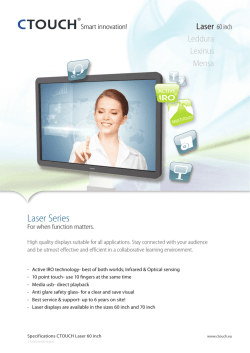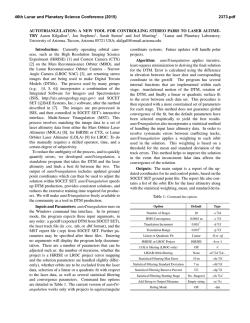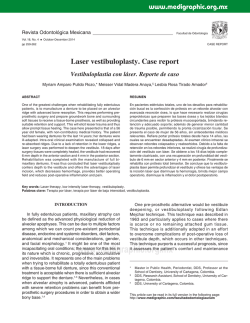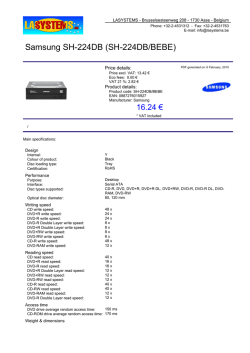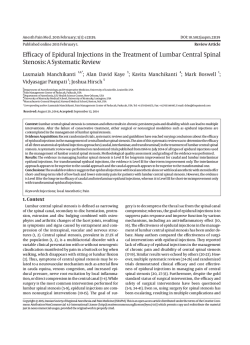
Decompression of the Intervertebral Disc Using Laser Energy Laser
MEDICAL POLICY POLICY TITLE DECOMPRESSION OF THE INTERVERTEBRAL DISC USING LASER ENERGY (LASER DISCECTOMY) OR RADIOFREQUENCY COBLATION (NUCLEOPLASTY) POLICY NUMBER MP-1.125 Original Issue Date (Created): July 26, 2011 Most Recent Review Date (Revised): November 25, 2014 Effective Date: POLICY RATIONALE DISCLAIMER POLICY HISTORY February 1, 2015 PRODUCT VARIATIONS DEFINITIONS CODING INFORMATION DESCRIPTION/BACKGROUND BENEFIT VARIATIONS REFERENCES I. POLICY Laser discectomy and radiofrequency coblation (disc nucleoplasty) are considered investigational as techniques of disc decompression and treatment of associated pain. There is insufficient evidence to support a conclusion concerning the health outcomes or benefits associated with these procedures. Cross-reference: MP-1.093 Artificial Intervertebral Disc MP-1.123 Automated Percutaneous Discectomy and Endoscopic Discectomy MP-1.021 Image-Guided Minimally Invasive Lumbar Decompression (IG-MLD) for Spinal Stenosis MP-1.124 Percutaneous Intradiscal Electrothermal (IDET) Annuloplasty and Percutaneous Intradiscal Radiofrequency Annuloplasty II. PRODUCT VARIATIONS TOP [N] = No product variation, policy applies as stated [Y] = Standard product coverage varies from application of this policy, see below [N] Capital Cares 4 Kids [N] Indemnity [N] PPO [N] SpecialCare [N] HMO [N] POS [N] SeniorBlue HMO [Y] FEP PPO* [N] SeniorBlue PPO Page 1 MEDICAL POLICY POLICY TITLE DECOMPRESSION OF THE INTERVERTEBRAL DISC USING LASER ENERGY (LASER DISCECTOMY) OR RADIOFREQUENCY COBLATION (NUCLEOPLASTY) POLICY NUMBER MP-1.125 * Refer to FEP Medical Policy Manual MP-7.01.93 Decompression of the Intervertebral Disc Using Laser Energy (Laser Discectomy) or Radiofrequency Coblation. The FEP Medical Policy manual can be found at: www.fepblue.org III. DESCRIPTION/BACKGROUND TOP Laser energy (laser discectomy) and radiofrequency coblation (nucleoplasty) are being evaluated for decompression of the intervertebral disc. For laser discectomy under fluoroscopic guidance, a needle or catheter is inserted into the disc nucleus, and a laser beam is directed through it to vaporize tissue. For DISC nucleoplasty™, bipolar radiofrequency energy is directed into the disc to ablate tissue. A variety of minimally invasive techniques have been investigated over the years as a treatment of low back pain related to disc disease. Techniques can be broadly divided into techniques that are designed to remove or ablate disc material, and thus decompress the disc, and those designed to alter the biomechanics of the disc annulus. The former category includes chymopapain injection, automated percutaneous lumbar discectomy, laser discectomy, and most recently disc decompression using radiofrequency energy, referred to as a DISC nucleoplasty™. Techniques that alter the biomechanics of the disc (disc annulus) include intradiscal electrothermal annuloplasty (i.e., the IDET procedure) or percutaneous intradiscal radiofrequency thermocoagulation (PIRT). It should be noted that 3 of these procedures use radiofrequency energy—disc nucleoplasty, IDET, and PIRT—but apply the energy in distinctly different ways such that the procedures are unique. Patients considered candidates for DISC nucleoplasty™ or laser discectomy include patients with bulging discs and sciatica. In contrast, the presence of a herniated disc is typically considered a contraindication for the IDET or PIRFT procedure. The IDET and PIRFT procedures, chymopapain injection, and automated percutaneous lumber discectomy are considered in separate policies. Laser discectomy and DISC nucleoplasty™ are the subjects of this policy A variety of different lasers have been investigated for laser discectomy, including YAG, KTP, holmium, argon, and carbon dioxide lasers. Due to differences in absorption, the energy requirements and the rate of application differ among the lasers. In addition, it is unknown how much disc material must be removed to achieve decompression. Therefore, protocols vary according to the length of treatment, but typically the laser is activated for brief periods only. The Disc nucleoplasty™ procedure uses bipolar radiofrequency energy in a process referred to as coblation technology. The technique consists of small, multiple electrodes that emit a fraction of the energy required by traditional radiofrequency energy systems. The result is that Page 2 MEDICAL POLICY POLICY TITLE DECOMPRESSION OF THE INTERVERTEBRAL DISC USING LASER ENERGY (LASER DISCECTOMY) OR RADIOFREQUENCY COBLATION (NUCLEOPLASTY) POLICY NUMBER MP-1.125 a portion of nucleus tissue is ablated, not with heat but with a low-temperature plasma field of ionized particles. These particles have sufficient energy to break organic molecular bonds within tissue, creating small channels in the disc. The proposed advantage of this coblation technology is that the procedure provides for a controlled and highly localized ablation, resulting in minimal therapy damage to surrounding tissue. Regulatory Status A number of laser devices have received U.S. Food and Drug Administration (FDA) 510(k) clearance for incision, excision, resection, ablation, vaporization, and coagulation of tissue. Intended uses described in FDA summaries include a wide variety of procedures, including percutaneous discectomy. Trimedyne, Inc. received 510(k) clearance in 2002 for the Trimedyne Holmium Laser System Ho1mium:Yttrium Aluminum Garnet (Ho1mium:YAG), Lisa Laser Products for Revolix Duo Laser System in 2007, and Quanta System LITHO Laser System in 2009. All were cleared, based on equivalence with predicate devices for percutaneous laser disc decompression/discectomy, including foraminoplasty, percutaneous cervical disc decompression/discectomy, and percutaneous thoracic disc decompression/discectomy. The summary for the Trimedyne system states that indications for cervical and thoracic decompression/discectomy include uncomplicated ruptured or herniated discs, sensory changes, imaging consistent with findings, and symptoms unresponsive to 12 weeks of conservative treatment. Indications for treatment of cervical discs also include positive nerve conduction studies. Arthrocare’s Perc-D SpineWand received 510(k) clearance in 2001 based on equivalence to predicate devices. It is used in conjunction with the Arthrocare Coblation System 2000 for ablation, coagulation, and decompression of disc material to treat symptomatic patients with contained herniated discs. IV. RATIONALE TOP Randomized, controlled trials (RCTs) are considered particularly important when assessing treatment of low back pain. RCTs are necessary to minimize the impact of demographic and clinical factors that can confound outcomes, to control for the expected placebo effect and other nonspecific effects of enrollment in a trial, and also to control for the variable natural history of low back pain, which may resolve with conservative treatment alone. Laser Discectomy Laser discectomy has been practiced for more than 20 years, and a fairly extensive literature describes different techniques using different types of lasers. Systematic Reviews. In 2013, Singh et al updated their 2009 systematic review of current evidence on percutaneous laser disc decompression.(1,2) There were 17 observational studies Page 3 MEDICAL POLICY POLICY TITLE DECOMPRESSION OF THE INTERVERTEBRAL DISC USING LASER ENERGY (LASER DISCECTOMY) OR RADIOFREQUENCY COBLATION (NUCLEOPLASTY) POLICY NUMBER MP-1.125 and no RCTs. Due to the lack of RCTs, meta-analysis could not be conducted, and evidence was considered to be limited, when rated according to U.S. Preventive Services Task Force criteria. In 2003, Gibson et al published a Cochrane review of surgery for lumbar disc prolapse, which included a review of laser discectomy.(3) This review concluded that unless or until better scientific evidence is available, laser discectomy should be regarded as a research technique. Their 2007 updated Cochrane review of surgical interventions for lumbar disc prolapse included 2 comparative studies on laser discectomy that were reported in U.S. Congress proceedings and abstracts.(4) One study, comparing 2 types of lasers, did not report comparative outcome results, and the other, which compared laser discectomy with chemonucleolysis, reported limited results favoring chemonucleolysis.(5,6) The review concluded that clinical outcomes following automated discectomy and laser discectomy “are at best fair and certainly worse than after microdiscectomy, although the importance of patient selection is acknowledged.” In a 2007 paper, Goupille et al reviewed the literature on laser disc decompression and concluded that “although the concept of laser disc nucleotomy is appealing, this treatment cannot be considered validated for disc herniation-associated radiculopathy resistant to medical treatment.”(7) They cite the lack of consensus regarding technique, the questionable methodology and conclusions of published studies, and the absence of a controlled study in their discussion. Controlled Cohort Studies. A retrospective review reported outcomes from 500 patients with discogenic pain and herniated discs treated with microdiscectomy (1997-2001 by 6 surgeons) and 500 patients treated with percutaneous laser disc decompression (2002-2004 by a single surgeon).(8) Patients with sequestered discs were excluded. This retrospective review found that the hospital stay (6 vs 2 days), overall recovery time (60 vs 35 days), and repeat procedure rates (7% vs 3%, all respectively) were lower in the laser group; these were not compared statistically. The percentage of patients with overall good/excellent outcomes (MacNab criteria) was found to be similar in the 2 groups (85.7% vs 83.8%, respectively) at the 2-year assessment; quantitative outcome measures were not reported. Observational Studies. Other than the comparative studies previously mentioned, the evidence for laser discectomy is limited to case series. In 2004, Choy described the largest series of 1275 patients treated with 2400 procedures (including cervical, thoracic, lumbar discs) over a period of 18.5 years, reporting an overall success rate, according to the MacNab criteria (measuring pain and function) of 89%.(9) “The complication rate (only infectious discitis) was 0.4%; all 10 patients with complications were cured with appropriate antibiotics. The recurrence rate was 5% and usually due to reinjury.” Menchetti et al reported a retrospective review of 900 patients treated with laser discectomy for herniated nucleus pulposus in 2011.(10) The success rate according to MacNab criteria at a mean of 5 years (range, 2-6 years) was 68%. Visual analog scores (VAS) for pain decreased from 8.5 preoperatively to 2.3 Page 4 MEDICAL POLICY POLICY TITLE DECOMPRESSION OF THE INTERVERTEBRAL DISC USING LASER ENERGY (LASER DISCECTOMY) OR RADIOFREQUENCY COBLATION (NUCLEOPLASTY) POLICY NUMBER MP-1.125 at 3-year follow-up and 3.4 at 5-year follow-up. There was a correlation between fair/poor results and subannular extrusion; 40% of these cases were treated with microsurgery after 1 to 3 months. In 2009, an article describing the design for an RCT was published by investigators in the Netherlands. (11) No results from this trial have been identified. Section Summary Evidence on decompression of the intervertebral disc using laser energy consists of observational studies. Given the variable natural history of back pain and the possibility of placebo effects with this treatment, observational studies are insufficient to permit conclusions concerning the effect of this technology on health outcomes. Radiofrequency Coblation (Disc Nucleoplasty) Systematic Reviews. At the time this policy was created, the literature on Disc nucleoplasty™ consisted of case series with no controlled trials. In 2009, Chou et al published a review of the evidence for nonsurgical interventions for low back pain for an American Pain Society guideline.(12) The authors noted that 1 lower quality systematic review identified no RCTs, and there was insufficient evidence from small case series to evaluate efficacy. A 2013 systematic review by Manchikanti et al identified 1 RCT and 14 observational studies on nucleoplasty that met inclusion criteria, concluding that evidence on nucleoplasty was limited to fair. (13) Randomized Controlled Trials. An industry-sponsored RCT from 2010 was an unblinded multicenter comparison of coblation nucleoplasty versus 2 epidural steroid injections. (14) The 85 patients included in the study had a focal disc protrusion and had failed conservative therapy. In addition, all patients had received an epidural steroid injection 3 weeks to 6 months previously with no relief, temporary relief, or partial relief of pain. At the 6-month follow-up, the mean improvement in VAS for leg pain, back pain, the Oswestry Disability Index (ODI), and 36-Item Short-Form Health Survey (SF-36) subscores were significantly greater in the nucleoplasty group. A greater percentage of patients in the nucleoplasty group also had a minimum clinically important change for leg pain, back pain, ODI, and SF-36 scores. A similar percentage of patients (27% of the nucleoplasty group, 20% of the epidural steroid group) had unresolved symptoms and received a secondary procedure during the first 6 months of the study. At 1-year follow-up, secondary procedure rates increased to 42% of the nucleoplasty group and 68% of the steroid group. By the 2-year follow-up, 44% of the nucleoplasty group and 73% of patients in the steroid group had secondary procedures, including 20 patients who had crossed over from steroid treatment to nucleoplasty. A 2012 unblinded RCT from Asia compared nucleoplasty with conservative treatment in 64 patients. (15) VAS at 15 days after treatment was reduced from a baseline of about 9 to about 5. The nucleoplasty group was reported to have a reduction in pain and medication use compared with conservatively treated controls at 1, 3, 6, and 12 months following treatment, Page 5 MEDICAL POLICY POLICY TITLE DECOMPRESSION OF THE INTERVERTEBRAL DISC USING LASER ENERGY (LASER DISCECTOMY) OR RADIOFREQUENCY COBLATION (NUCLEOPLASTY) POLICY NUMBER MP-1.125 although the data were not presented in this brief report. Comparison of magnetic resonance imaging (MRI) at baseline and after treatment showed a decrease in the bulging of the disc from 5.09 mm to 1.81 mm at 3 months after nucleoplasty. Controlled Cohort Studies. Bokov et al reported a nonrandomized cohort study comparing nucleoplasty and microdiscectomy in 2010. (16) Patients undergoing nucleoplasty were divided into those with a disc protrusion n=46) or a disc extrusion (n=27). The patients with disc extrusion chose nucleoplasty, despite a total annulus disruption. Patients were examined at 1, 3, 6, 12, and 18 months with VAS for pain and ODI. A satisfactory result was defined as a 50% decrease in VAS and a 40% decrease in ODI. For patients with a disc protrusion treated with nucleoplasty, satisfactory results were obtained in 36 (78%). For patients with a disc protrusion treated with microdiscectomy, a satisfactory result was observed in 61 patients (94%). For patients with a disc extrusion, nucleoplasty had a significantly higher rate of unsatisfactory results; clinically significant improvements were observed in 12 cases (44%), and 9 patients (33%) with disc extrusion treated with nucleoplasty subsequently underwent microdiscectomy for exacerbation of pain. In 2009, Birnbaum compared outcomes from a series of 26 patients with cervical disc herniation treated with disc nucleoplasty with a group of 30 patients who received conservative treatment with bupivacaine and prednisolone acetate.(17) Baseline VAS was 8.4 in the control group and 8.8 in the nucleoplasty group. At 1 week, scores were 7.3 and 3.4, respectively, and at 24 months, 5.1 and 2.3, respectively. No other outcome data were provided. Other. Cuellar et al reported accelerated degeneration after failed nucleoplasty.(18) Of 54 patients referred for persistent pain after nucleoplasty, 28 patients were evaluated by MRI to determine the source of their symptoms. VAS for pain in this cohort was 7.3. At a mean follow-up of 24 weeks (range, 6-52) after nucleoplasty, no change was observed between the baseline and postoperative MRI for increased signal hydration, disc space height improvement, or shrinkage of the preoperative disc bulge. Of 17 cervical levels treated in 12 patients, 5 (42% of patients) appeared to show progressive degeneration at treated levels. Of 17 lumbar procedures in 16 patients, 4 (15% of patients) showed progressive degeneration. Overall, a total of 26% of the patients in this series showed progressive degeneration at the treated level less than 1 year after nucleoplasty. The proportion of discs showing progressive degeneration of the total nucleoplasty procedures performed cannot be determined from this study. It is also unknown whether any morphologic changes occur after nucleoplasties that were considered to be successful. Additional study of this potential adverse effect of nucleoplasty is needed. Section Summary Two small RCTs have been published on nucleoplasty. One was a small RCT from Asia that compared nucleoplasty with conservative therapy. The other RCT was an industry-sponsored comparison of coblation nucleoplasty versus epidural steroid injections in a group of patients Page 6 MEDICAL POLICY POLICY TITLE DECOMPRESSION OF THE INTERVERTEBRAL DISC USING LASER ENERGY (LASER DISCECTOMY) OR RADIOFREQUENCY COBLATION (NUCLEOPLASTY) POLICY NUMBER MP-1.125 who had already failed the control intervention. At 6-month follow-up, scores for pain and functional status were superior for the nucleoplasty group, but a similar percentage of patients in the 2 groups had unresolved symptoms and received a secondary procedure. In the observational phase of the study (2-year follow-up), there was a higher percentage of patients (50%) in the control group who crossed over to nucleoplasty. The manner in which alternative interventions were offered in the observational phase is uncertain. Overall, interpretation of these study results is limited. Results from a cohort study support the conclusion that nucleoplasty is not as effective as microdiscectomy for disc extrusion. Prospective controlled trials of nucleoplasty versus microdiscectomy are needed to evaluate efficacy and time for recovery in patients with disc protrusion. Notably, 1 case series reported accelerated degeneration after nucleoplasty. Adequate follow-up with MRI is needed to determine if nucleoplasty accelerates disc degeneration. Ongoing and Unpublished Clinical Trials A search of online site www.ClinicalTrials.gov in June 2014 identified 1 new trial from Europe that will compare nucleoplasty with pulsed radiofrequency of the nerve or dorsal root ganglion (NCT01797172). Thirty-eight patients will be enrolled with completion expected in 2014. Two recent trials are listed as completed but no publications have been identified: An industry-sponsored RCT of nucleoplasty compared with conservative care (NCT00940810). The study has an estimated enrollment of 46 patients with completion noted November 2011. No results are posted. An industry-sponsored sham-controlled RCT on nucleoplasty (NCT00124774) is listed as completed as of April 2006. No results are posted. Summary While numerous case series and uncontrolled studies report improvements in pain and functioning following laser discectomy, the lack of well-designed and conducted controlled trials limits interpretation of reported data. For nucleoplasty, there are 2 small randomized controlled trials in addition to the uncontrolled studies, but these trials are limited by the lack of blinding, an inadequate control condition in 1 trial and inadequate data reporting in the second. Questions remain about the safety and efficacy of these treatments. Reconsideration of the policy position awaits high-quality randomized trials with adequate follow-up (at least 1 year) that control for selection bias, the placebo effect, and variability in the natural history of low back pain. These procedures are considered investigational. Practice Guidelines and Position Statements The National Institute for Clinical Excellence guidance from 2009 on laser lumbar discectomy, states that current evidence “is inadequate in quantity and quality,” that this procedure should only be used with special arrangements for clinical governance, consent, and Page 7 MEDICAL POLICY POLICY TITLE DECOMPRESSION OF THE INTERVERTEBRAL DISC USING LASER ENERGY (LASER DISCECTOMY) OR RADIOFREQUENCY COBLATION (NUCLEOPLASTY) POLICY NUMBER MP-1.125 audit or research, and that patients should understand the uncertainty about the safety and efficacy of the procedure.(19) Guidance on percutaneous disc decompression using coblation for lower back pain was published in 2006 stating that there is some evidence of short-term efficacy; however “this is not sufficient to support the use of this procedure without special arrangements for consent and audit or research.”(20) A 2009 American Pain Society clinical practice guideline on nonsurgical interventions for low back pain states that “there is insufficient (poor) evidence from randomized trials (conflicting trials, sparse and lower quality data, or no randomized trials) to reliably evaluate” a number of interventions including coblation.(12,21) Practice guidelines were published in 2009 and updated in 2013 by the American Society of Interventional Pain Physicians.(22,23) The 2013 guidelines found limited evidence for percutaneous laser disc decompression and limited to fair evidence for nucleoplasty, as described in the 2013 systematic reviews by Singh et al and Manchikanti et al.(2,13). U.S. Preventative Task Service Recommendations Decompression of the intervertebral disc using laser energy or radiofrequency coblation is not a preventive service. Medicare National Coverage The Centers for Medicare and Medicaid Services (CMS) has determined that thermal intradiscal procedures, including percutaneous (or plasma) disc decompression or coblation, are not reasonable and necessary for the treatment of low back pain. Therefore, thermal intradiscal procedures, which include procedures that employ the use of a radiofrequency energy source or electrothermal energy to apply or create heat and/or disruption within the disc for the treatment of low back pain, are noncovered. (24) CMS has not published a national coverage decision regarding laser discectomy; however, it states the following in its decision on laser procedures: “Medicare recognizes the use of lasers for many medical indications. Procedures performed with lasers are sometimes used in place of more conventional techniques. In the absence of a specific noncoverage instruction, and where a laser has been approved for marketing by the Food and Drug Administration, contractor discretion may be used to determine whether a procedure performed with a laser is reasonable and necessary and, therefore, covered.”(25) V. DEFINITIONS TOP ABLATION IS the removal of a part, pathway, or function by surgery, chemical destruction, electrocautery or radiofrequency. Page 8 MEDICAL POLICY POLICY TITLE DECOMPRESSION OF THE INTERVERTEBRAL DISC USING LASER ENERGY (LASER DISCECTOMY) OR RADIOFREQUENCY COBLATION (NUCLEOPLASTY) POLICY NUMBER MP-1.125 INTERVERTEBRAL DISC is the fibrocartilaginous tissue between the vertebral bodies. The outer portion is the annulus fibrosus; the inner portion is the nucleus pulposus. The disc is the shock absorber, or cushion, and permits movement. MINIMALLY INVASIVE PROCEDURES also called minimal access procedures used to perform spinal surgeries. These may include the following: (Note; this is not an all-inclusive list.) ALIF – anterior lumbar interbody fusion AxiaLIF – axial approach to interbody fusion which is performed perpendicular to the long axis of the spine with access through the sacrum. Also called anterior paraaxial, trans-sacral or paracoccygeal interbody fusion performed with the AxiaLIF® and AxiaLIF 2 Level systems. DLIF - Direct lateral interbody fusion IDET – intradiscal electrothermal annuloplasty IG-MLD – image-guided minimally invasive lumbar decompression. LASE – annuloplasty using a laser-assisted spinal endoscopy LTIF – lateral transpsoas interbody fusion MEDL – microendoscopic decompressive laminotomy MILD – microscopic muscle-preserving interlaminar decompression involves a small skin incision at the interspinous level and partial drilling of the spinous process. PELA – percutaneous endoscopic laser annuloplasty. PLD – percutaneous lumbar discectomy PIRFT – percutaneous intradiscal radiofrequency thermocoagulation PLIF – posterior lumbar interbody fusion TLIF – transforaminal interbody fusion XLIF –Extreme lateral interbody fusion VI. BENEFIT VARIATIONS TOP The existence of this medical policy does not mean that this service is a covered benefit under the member's contract. Benefit determinations should be based in all cases on the applicable contract language. Medical policies do not constitute a description of benefits. A member’s individual or group customer benefits govern which services are covered, which are excluded, Page 9 MEDICAL POLICY POLICY TITLE DECOMPRESSION OF THE INTERVERTEBRAL DISC USING LASER ENERGY (LASER DISCECTOMY) OR RADIOFREQUENCY COBLATION (NUCLEOPLASTY) POLICY NUMBER MP-1.125 and which are subject to benefit limits and which require preauthorization. Members and providers should consult the member’s benefit information or contact Capital for benefit information. VII. DISCLAIMER TOP Capital’s medical policies are developed to assist in administering a member’s benefits, do not constitute medical advice and are subject to change. Treating providers are solely responsible for medical advice and treatment of members. Members should discuss any medical policy related to their coverage or condition with their provider and consult their benefit information to determine if the service is covered. If there is a discrepancy between this medical policy and a member’s benefit information, the benefit information will govern. Capital considers the information contained in this medical policy to be proprietary and it may only be disseminated as permitted by law. VIII. CODING INFORMATION TOP Note: This list of codes may not be all-inclusive, and codes are subject to change at any time. The identification of a code in this section does not denote coverage as coverage is determined by the terms of member benefit information. In addition, not all covered services are eligible for separate reimbursement. Investigational, and therefore not covered, when used to report minimally invasive disc procedures as outlined in the Policy section: CPT Codes® 62287 77002 Current Procedural Terminology (CPT) copyrighted by American Medical Association. All Rights Reserved. Investigational; therefore not covered: HCPCS Code Description S2348 Decomp perq intervert disc rf energy 1/mx lumb *If applicable, please see Medicare LCD or NCD for additional covered diagnoses. ICD-9Surgical Procedure codes Description 80.59 Other destruction of intervertebral disc (including that by laser) Page 10 MEDICAL POLICY POLICY TITLE DECOMPRESSION OF THE INTERVERTEBRAL DISC USING LASER ENERGY (LASER DISCECTOMY) OR RADIOFREQUENCY COBLATION (NUCLEOPLASTY) POLICY NUMBER MP-1.125 ICD-9-CM Diagnosis Code* 722.0 722.10 722.11 722.22 722.30 722.31 722.32 722.39 722.4 722.51 722.52 722.6 722.70 722.71 722.72 722.73 722.80 722.81 722.82 722.83 722.90 722.91 722.92 722.93 Description Intervertebral disc disorders; Displacement of cervical intervertebral disc without myelopathy Intervertebral disc disorders Displacement of thoracic or lumbar intervertebral disc without myelopathy; Lumbar intervertebral disc without myelopathy Intervertebral disc disorders; Displacement of thoracic or lumbar intervertebral disc without myelopathy ;Thoracic intervertebral disc without myelopathy Displacement of thoracic or lumbar intervertebral disc without myelopathy; Displacement of intervertebral disc, site unspecified, without myelopathy Displacement of thoracic or lumbar intervertebral disc without myelopathy; Schmorl's nodes; Unspecified region Displacement of thoracic or lumbar intervertebral disc without myelopathy; Schmorl's nodes; Thoracic region Displacement of thoracic or lumbar intervertebral disc without myelopathy; Schmorl's nodes; Lumbar region Displacement of thoracic or lumbar intervertebral disc without myelopathy; Schmorl's nodes; Other Displacement of thoracic or lumbar intervertebral disc without myelopathy; Schmorl's nodes; Other Degeneration of thoracic or lumbar intervertebral disc; Thoracic or thoracolumbar intervertebral disc Degeneration of thoracic or lumbar intervertebral disc; Lumbar or lumbosacral intervertebral disc Degeneration of thoracic or lumbar intervertebral disc Intervertebral disc disorder with myelopathy; Unspecified region Intervertebral disc disorder with myelopathy; Cervical region Intervertebral disc disorder with myelopathy; Thoracic region Intervertebral disc disorder with myelopathy; Lumbar region Postlaminectomy syndrome; Unspecified region Postlaminectomy syndrome; Cervical region Postlaminectomy syndrome; Thoracic region Postlaminectomy syndrome; Lumbar region Other and unspecified disc disorder; Unspecified region Other and unspecified disc disorder; Cervical region Other and unspecified disc disorder; Thoracic region "Other and unspecified disc disorder; Lumbar region Page 11 MEDICAL POLICY POLICY TITLE DECOMPRESSION OF THE INTERVERTEBRAL DISC USING LASER ENERGY (LASER DISCECTOMY) OR RADIOFREQUENCY COBLATION (NUCLEOPLASTY) POLICY NUMBER MP-1.125 The following ICD-10 diagnosis codes will be effective October 1, 2015: ICD-10-CM Diagnosis Code* M46.40 M46.41 M46.42 M46.43 M46.44 M46.45 M46.46 M46.47 M46.48 M46.49 M50.10 M50.11 M50.12 M50.13 M50.20 M50.21 M50.22 M50.23 M50.30 M50.31 M50.32 M52.33 M50.80 M50.81 M50.82 M50.83 M50.90 M50.91 M50.92 M50.93 M51.04 Description Discitis, unspecified, site unspecified Discitis, unspecified, occipito-atlanto-axial region Discitis, unspecified, cervical region Discitis, unspecified, cervical region Discitis, unspecified, thoracic region Discitis, unspecified, thoracolumbar region Discitis, unspecified, lumbar region Discitis, unspecified, lumbosacral region Discitis, unspecified, sacral and sacrococcygeal region Discitis, unspecified, multiple sites in spine Cervical disc disorder with radiculopathy, unspecified cervical region Cervical disc disorder with radiculopathy, high cervical region Cervical disc disorder with radiculopathy, mid-cervical region Cervical disc disorder with radiculopathy, cervicothoracic region Other cervical disc displacement, unspecified cervical region Other cervical disc displacement, high cervical region Other cervical disc displacement, mid-cervical region Other cervical disc displacement, cervicothoracic region Other cervical disc degeneration, unspecified cervical region Other cervical disc degeneration, high cervical region Other cervical disc degeneration, mid-cervical region Other cervical disc degeneration, cervicothoracic region Other cervical disc disorders, unspecified cervical region Other cervical disc disorders, high cervical region Other cervical disc disorders ; Other cervical disc disorders, mid-cervical region Other cervical disc disorders, cervicothoracic region Cervical disc disorder, unspecified, unspecified cervical region Cervical disc disorder, unspecified, high cervical region Cervical disc disorder, unspecified, mid-cervical region Cervical disc disorder, unspecified, cervicothoracic region Thoracic, thoracolumbar and lumbosacral intervertebral disc disorders with myelopathy; Intervertebral disc disorders with myelopathy, thoracic region Page 12 MEDICAL POLICY POLICY TITLE DECOMPRESSION OF THE INTERVERTEBRAL DISC USING LASER ENERGY (LASER DISCECTOMY) OR RADIOFREQUENCY COBLATION (NUCLEOPLASTY) POLICY NUMBER MP-1.125 ICD-10-CM Diagnosis Description Code* M51.05 Thoracic, thoracolumbar and lumbosacral intervertebral disc disorders with myelopathy; Intervertebral disc disorders with myelopathy, thoracolumbar region M51.06 Thoracic, thoracolumbar and lumbosacral intervertebral disc disorders with myelopathy ;Intervertebral disc disorders with myelopathy, lumbar region M51.14 Thoracic, thoracolumbar and lumbosacral intervertebral disc disorders with radiculopathy; Intervertebral disc disorders with radiculopathy, thoracic region M51.15 Thoracic, thoracolumbar and lumbosacral intervertebral disc disorders with radiculopathy; Intervertebral disc disorders with radiculopathy, thoracolumbar region M51.16 Thoracic, thoracolumbar and lumbosacral intervertebral disc disorders with radiculopathy; Intervertebral disc disorders with radiculopathy, lumbar region M51.17 Thoracic, thoracolumbar and lumbosacral intervertebral disc disorders with radiculopathy; Intervertebral disc disorders with radiculopathy, lumbosacral region M51.24 Other intervertebral disc displacement, thoracic region M51.25 Other intervertebral disc displacement, thoracolumbar region M51.26 Other intervertebral disc displacement, lumbar region M51.27 Other intervertebral disc displacement, lumbosacral region M51.34 Other intervertebral disc degeneration, thoracic region M51.35 Other intervertebral disc degeneration, thoracolumbar region M51.36 Other intervertebral disc degeneration, lumbar region M54.37 Other intervertebral disc degeneration, lumbosacral region M51.44 Schmorl's nodes, thoracic region M51.45 Schmorl's nodes, thoracolumbar region M51.46 Schmorl's nodes, lumbar region M54.47 Schmorl's nodes, lumbosacral region M51.84 Other intervertebral disc disorders, thoracic region M51.85 Other intervertebral disc disorders, thoracolumbar region M51.86 Other intervertebral disc disorders, lumbar region M18.87 Other intervertebral disc disorders, lumbosacral region M51.9 Unspecified thoracic, thoracolumbar and lumbosacral intervertebral disc disorder *If applicable, please see Medicare LCD or NCD for additional covered diagnoses. IX. REFERENCES TOP 1. Singh V, Manchikanti L, Benyamin RM et al. Percutaneous lumbar laser disc decompression: a systematic review of current evidence. Pain Physician 2009; 12(3):57388. Page 13 MEDICAL POLICY POLICY TITLE DECOMPRESSION OF THE INTERVERTEBRAL DISC USING LASER ENERGY (LASER DISCECTOMY) OR RADIOFREQUENCY COBLATION (NUCLEOPLASTY) POLICY NUMBER MP-1.125 2. Singh V, Manchikanti L, Calodney AK et al. Percutaneous lumbar laser disc decompression: an update of current evidence. Pain Physician 2013; 16(2 Suppl):SE22960. 3. Gibson JN, Grant IC, Waddell G. Surgery for lumbar disc prolapse (Cochrane Review). The Cochrane Libary 2003; Issue 2. 4. Gibson JN, Waddell G. Surgical interventions for lumbar disc prolapse. Cochrane Database Syst Rev 2007; (2):CD001350. 5. Hellinger PM. Nd-YAG (104nm) versus diode (940nm) PLDN: a prospective randomized blinded study. In: Brock M SW, Wille C, ed. Proceedings from the first Interdisciplinary World Congress on Spinal Surgery and Related Disciplines 2000:555-8. 6. Steffen R, Luetke A, Wittenberg RH et al. A prospective comparative study of chemonucleolysis and laser discectomy. Orthop Trans 1996; 20:388. 7. Goupille P, Mulleman D, Mammou S et al. Percutaneous laser disc decompression for the treatment of lumbar disc herniation: a review. Semin Arthritis Rheum 2007; 37(1):20-30. 8. Tassi GP. Comparison of results of 500 microdiscectomies and 500 percutaneous laser disc decompression procedures for lumbar disc herniation. Photomed Laser Surg 2006; 24(6):694-7. 9. Choy DS. Percutaneous laser disc decompression: an update. Photomed Laser Surg 2004; 22(5):393-406. 10. Menchetti PP, Canero G, Bini W. Percutaneous laser discectomy: experience and long term follow-up. Acta Neurochir Suppl 2011; 108:117-21. 11. Brouwer PA, Peul WC, Brand R et al. Effectiveness of percutaneous laser disc decompression versus conventional open discectomy in the treatment of lumbar disc herniation; design of a prospective randomized controlled trial. BMC Musculoskelet Disord 2009; 10:49. 12. Chou R, Atlas SJ, Stanos SP et al. Nonsurgical interventional therapies for low back pain: a review of the evidence for an American Pain Society clinical practice guideline. Spine (Phila Pa 1976) 2009; 34(10):1078-93. 13. Manchikanti L, Falco FJ, Benyamin RM et al. An update of the systematic assessment of mechanical lumbar disc decompression with nucleoplasty. Pain Physician 2013; 16(2 Suppl):SE25-54. 14. Gerszten PC, Smuck M, Rathmell JP et al. Plasma disc decompression compared with fluoroscopy-guided transforaminal epidural steroid injections for symptomatic contained lumbar disc herniation: a prospective, randomized, controlled trial. J Neurosurg Spine 2010; 12(4):357-71. 15. Chitragran R, Poopitaya S, Tassanawipas W. Result of percutaneous disc decompression using nucleoplasty in Thailand: a randomized controlled trial. J Med Assoc Thai 2012; 95 Suppl 10:S198-205. Page 14 MEDICAL POLICY POLICY TITLE DECOMPRESSION OF THE INTERVERTEBRAL DISC USING LASER ENERGY (LASER DISCECTOMY) OR RADIOFREQUENCY COBLATION (NUCLEOPLASTY) POLICY NUMBER MP-1.125 16. Bokov A, Skorodumov A, Isrelov A et al. Differential treatment of nerve root compression pain caused by lumbar disc herniation applying nucleoplasty. Pain Physician 2010; 13(5):469-80. 17. Birnbaum K. Percutaneous cervical disc decompression. Surg Radiol Anat 2009; 31(5):379-87. 18. Cuellar VG, Cuellar JM, Vaccaro AR et al. Accelerated degeneration after failed cervical and lumbar nucleoplasty. J Spinal Disord Tech 2010; 23(8):521-4. 19. National Institute for Clinical Excellence (NICE). Percutaneous endoscopic laser lumbar discectomy. Interventional Procedure Guidance 300. 2009. Available online at: http://www.nice.org.uk/nicemedia/live/12073/44256/44256.pdf. Last accessed May, 2014. 20. National Institute for Clinical Excellence (NICE). Percutaneous disc decompression using coblation for lower back pain. Interventional Procedure Guidance 173. 2006. Available online at: http://guidance.nice.org.uk/IPG173/Guidance/pdf/English. Last accessed May, 2014. 21. Chou R, Loeser JD, Owens DK et al. Interventional therapies, surgery, and interdisciplinary rehabilitation for low back pain: an evidence-based clinical practice guideline from the American Pain Society. Spine (Phila Pa 1976) 2009; 34(10):1066-77. 22. Manchikanti L, Derby R, Benyamin RM et al. A systematic review of mechanical lumbar disc decompression with nucleoplasty. Pain Physician 2009; 12(3):561-72. 23. Manchikanti L, Abdi S, Atluri S et al. An update of comprehensive evidence-based guidelines for interventional techniques in chronic spinal pain. Part II: Guidance and recommendations. Pain Physician 2013; 16(2 Suppl):S49-S283. 24. Centers for Medicare and Medicaid. NCD for Thermal Intradiscal Procedures (TIPs) (150.11). 2009. Available online at: http://www.cms.gov/medicare-coveragedatabase/details/ncddetails.aspx?NCDId=324&ncdver=1&DocID=150.11&bc=gAAAAAgAAAAA&. Last accessed May, 2014. 25. Centers for Medicare and Medicaid. NCD for LASER Procedures (140.5). 1997. Available online at: http://www.cms.gov/medicare-coverage-database/details/ncddetails.aspx?NCDId=69&ncdver=1&DocID=140.5&bc=gAAAAAgAAAAA&. Last accessed May, 2014 Other: 1. Taber’s Cyclopedic Medical Dictionary, 20th edition. Page 15 MEDICAL POLICY POLICY TITLE DECOMPRESSION OF THE INTERVERTEBRAL DISC USING LASER ENERGY (LASER DISCECTOMY) OR RADIOFREQUENCY COBLATION (NUCLEOPLASTY) POLICY NUMBER MP-1.125 X. POLICY HISTORY MP 1.125 TOP CAC 7/26/11 New policy, Adopt BCBSA. BCBSA language adoption did not change intent of policy statements. Other minimally invasive procedures extracted from CBC MP-1.021 Image-Guided Minimally Invasive Lumbar Decompression (IG-MLD) for Spinal Stenosis (formerly Minimally Invasive Disc Procedures) and separated into individual policies. See MP 1.123 Automated Percutaneous Discectomy, MP 1.124 Percutaneous Intradiscal Electrothermal (IDET) Annuloplasty and Percutaneous Intradiscal Radiofrequency Annuloplasty, and MP 1.126 Minimally Invasive Lumbar Interbody Fusion. CAC 10/30/12 Consensus review. References updated; no changes to policy statement. FEP variation revised. Medicare variation removed. CODES REVIEWED 10/25/12 KLR 03/28/13- Admin code changes-skb 11/26/13 Consensus. No change to policy statement. References updated. Rationale section added. CAC 11/25/14 Consensus review. No changes to the policy statements. References and rationale updated. Coding reviewed, no changes. Top Health care benefit programs issued or administered by Capital BlueCross and/or its subsidiaries, Capital Advantage Insurance Company®, Capital Advantage Assurance Company® and Keystone Health Plan® Central. Independent licensees of the BlueCross BlueShield Association. Communications issued by Capital BlueCross in its capacity as administrator of programs and provider relations for all companies. Page 16
© Copyright 2026

